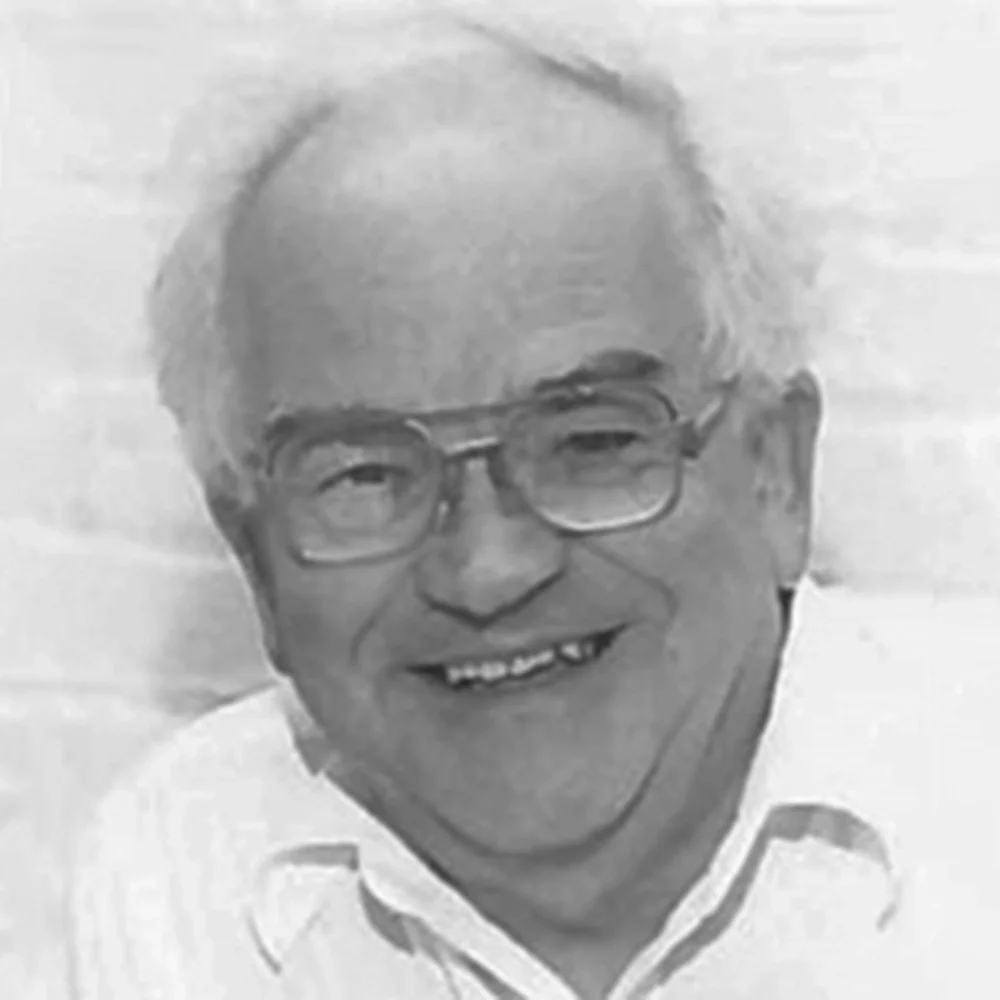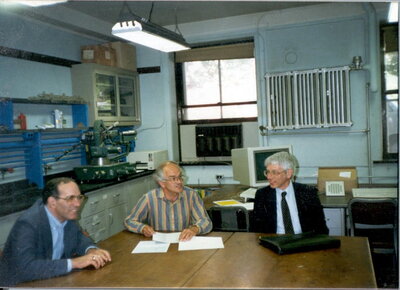
An accomplished crystallographer known for his pioneering research in solid state chemistry, Emeritus Professor of Chemistry Iain C. Paul, 83, passed away on Dec. 12, 2021, in Urbana-Champaign.
A faculty member from 1964 to 2021, Paul began to study solid-state transformations in the 1960s with the late David Curtin (PhD, ’45), who was a fellow Illinois chemistry faculty member at that time.
“Their studies were truly transformative,” said Bruce M. Foxman, Emeritus Professor of Chemistry at Brandeis University, who was a colleague and friend of Paul. “At that time, published studies focused on attempts to correlate crystal structure with the nature of the reaction product obtained in the solid state. Significantly, Iain and Dave expanded the approach, providing an interpretation of the experimentally-observed physical changes in reacting crystals.”
Referencing a compilation of papers by Paul and Curtin from 1970 to 1994, Foxman said they all involved cutting-edge science and are still compelling, pertinent reading today.
“Together Iain and Dave inspired a generation of young scientists, myself included, to employ their key new approach to the study of solid-state reactivity,” he said.

Photo courtesy of Bruce Foxman.
Foxman first met Paul when he invited him to Brandeis in the ‘70s to present a seminar.
“I found him to be a very friendly, down-to-earth, and supportive colleague, and the visit was the beginning of a long friendship,” he said. “Later, I was invited to visit the University of Illinois, and to present both a seminar and a lecture in Iain and Dave's solid-state chemistry course. During that visit Iain introduced me to Joel Bernstein, who was visiting the group at that time, and this resulted in another lifelong friendship.”
A Scotsman who was born in Clydebank, Paul attended Glasgow University as an undergraduate and graduate student, finishing his PhD in 1962. After two years of postdoctoral work at Harvard University, he joined the Illinois faculty in 1964, where his main research interests were in organic and structural chemistry, involving the use of X-ray crystallography to determine the crystal and molecular structures of a number of classes of organic compounds.
John Katzenellenbogen, research professor of chemistry at Illinois, said when he joined the faculty in 1969, Paul was an associate professor in the Physical Chemistry area. Paul’s collaborative research with Curtin involved heat or light-induced chemical reactions that took place within the crystalline state.
“The chemical transformations would sometimes take place with no change in crystal structure, in other cases with some crystal modifications and sometimes with fragmentation of the crystalline state altogether,” Katzenellenbogen explained. “Dr. Paul would characterize the molecular structure before and after the chemical transformation. This was unusual research at the time, and their joint publications were admired by the field.”
Katzenellenbogen said later in Paul’s career, he set up the precursor of what has become the Department of Chemistry’s current service facility, the George L. Clark X-Ray Facility and 3M Materials Laboratory. Along with Curtin, Katzenellenbogen said Paul trained some of today's leaders in the field of solid state chemistry, including Gautam R. Desiraju (PhD, ’76; MS, '74), who has become a major figure in chemistry, especially crystal engineering.
Currently a professor at the Indian Institute of Science in Bangalore, India, Desiraju was previously a professor at the University of Hyderabad, and from 2011 to 2014, was the President of the International Union of Crystallography.
Desiraju said he was the only one among his class of more than 100 PhD students who chose to explore with Paul and Curtin the “then nascent topic of organic solid state reactions,” which was on the fringe of chemistry then. Now it has evolved into what’s known as crystal engineering, and its major offshoot, the study of porous organic and metal-organic solids.
“Today it has become a major research activity in chemistry with implications in separation, synthesis, catalysis, pharmaceuticals and energy related issues,” Desiraju explained. “Of course, none of this could have been predicted 50 years ago when I joined Professors Curtin and Paul for my PhD degree.”
Desiraju said it’s difficult to talk about Paul in an academic sense without including Curtin, because they had a unique collaboration in those days. Typically, students would spend a year or two with Curtin in RAL, he explained, before crossing South Mathews Avenue to Noyes Laboratory to spend the rest of their PhD careers with Paul.
He noted the contrast between his two co-supervisors. The younger Paul was more detail-oriented and enjoyed talking about general things like music and politics and other topics, Desiraju explained, but Curtin, the older chemist, saw the big picture, and did not concern himself with details.
"And I don’t believe any of us students had the nerve to talk with (Curtin) about non-chemistry matters. Yet, these two gentlemen formed a single academic entity, and my thesis did not look like two bits pasted together,” he said, recalling Paul's attention to detail during the review of his thesis.
“He (Paul) spent several days with these typed sheets and came back with a very long list of things he wanted changed. These were all minor points but what struck me was the meticulousness of his approach,” said Desiraju, adding that he learned an important lesson from Paul, which has benefited him enormously over the last 45 years in his own rewarding academic career. “There is no substitute for over diligence, over caution and over carefulness in academic life."
Katzenellenbogen described his former colleague as somewhat reserved in manner, yet friendly and caring.
Toward the end of Paul’s career, his research activity wound down following Curtin’s retirement, but Paul continued to teach. Katzenellenbogen remembered being present when the Department Head at the time asked Paul to take on a larger teaching load.
“Without hesitation Paul replied, ‘I would be glad to do it. In fact, I am pleased that you have thought of a way that I can make a greater contribution to the department.’ Dr. Iain Paul was a true gentleman with a big heart,” Katzenellenbogen said.
Joseph A. Stanko (PhD, ’66), retired associate professor at the University of South Florida, first became acquainted with Paul when his research as a graduate student in Inorganic Chemistry necessitated a need for a crystal structure determination.
“I clearly remember Prof. (Theron “Stan) Piper taking me down to the basement floor of Noyes lab to ‘shop me around,’ Stanko said. “It was only Prof. Paul who offered to take me on. He and his group began to teach me the use of X-ray diffraction to obtain detailed structure of molecules in crystals. Looking back, I am so grateful for having that opportunity to learn X-ray crystallography from Professor Paul, an instrumental technique which has become so essential to all aspects of chemistry and biochemistry over the last several decades.”
Foxman remembered asking for Paul’s advice once and getting much more in return.
While up for tenure at Brandeis, Foxman had volunteered to organize and host the Vth International Conference on the Chemistry of the Organic Solid State (ICCOSS). Worried he was taking on too much, he sought advice from Paul, who told him the conference would be beneficial to his career and then volunteered to help organize it.
“In those years of snail mail, telephones and telegrams-only, one might think that the Illinois-Massachusetts distance would have prevented Iain from providing the help I would need. It was quite the contrary: he wrote letters, raised funds, made phone calls, helped me with the brochure and mailings, as well as the preparation of a successful NSF proposal for the conference. He was the very best of partners. The event was a wonderful success,” he said.
Foxman’s favorite memory of Paul took place in 1985 after an ICCOSS conference dinner in Crete. To the delight of Foxman's young children and other guests, Foxman said Paul participated in an "amazing, Greek dish-smashing dance."
“Over the years we enjoyed many fruitful and productive interactions," Foxman said. "Iain was a dear friend, a brilliant scientist, a man of great integrity with a wonderful sense of humor, and a superior mentor both within and outside the University. He shall be missed.”
Desiraju met with Paul a few times after his PhD years, but he said his visit to UIUC in 1996 hosted by Paul was special.
“By then I had gained recognition of some sort but delivering a lecture in the same room where I had given my first student seminar 23 years previously was memorable. Prof. Paul introduced me and his words on that occasion had all the flavor of natural pride and pleasure that a teacher would have with regard to a student who was climbing professionally,” he said.
Desiraju said he is still the proud owner of a set of Paul Heinrich von Gröth’s five volume 1883 magnum opus, Chemische Kristallographie, which Paul procured after driving “all the way to some place in Indiana” where this pristine set of volumes was being sold.
“Possibly he got to know about them through his connections with antiques and curios,” he said.
Paul enjoyed a second career in the antique business, along with his wife, Michelle (Sue) Overman. He was one of the original founders of Vintage Antiques in downtown Champaign, which operated for nearly 25 years. He and his wife ran estate sales and were regulars at the Bement, Homer, Clingan and Gordyville auctions.
Desiraju said it gives him the greatest joy to acknowledge his debt to Paul, his co-supervisor who first taught him about X-ray crystallography just as Paul had learned from his advisor, the legendary J. Monteath Robertson, one of the founders of the subject.
“Prof. Robertson’s imprint remains very strongly on me and seriously influenced my phrasing of the molecule to crystal problem, the cornerstone of crystal engineering. Thank you, Iain, for everything and most important for giving me confidence in myself and my abilities. This is the ultimate test of a teacher, and you pass with flying colors,” he said.
— Tracy Crane, Department of Chemistry